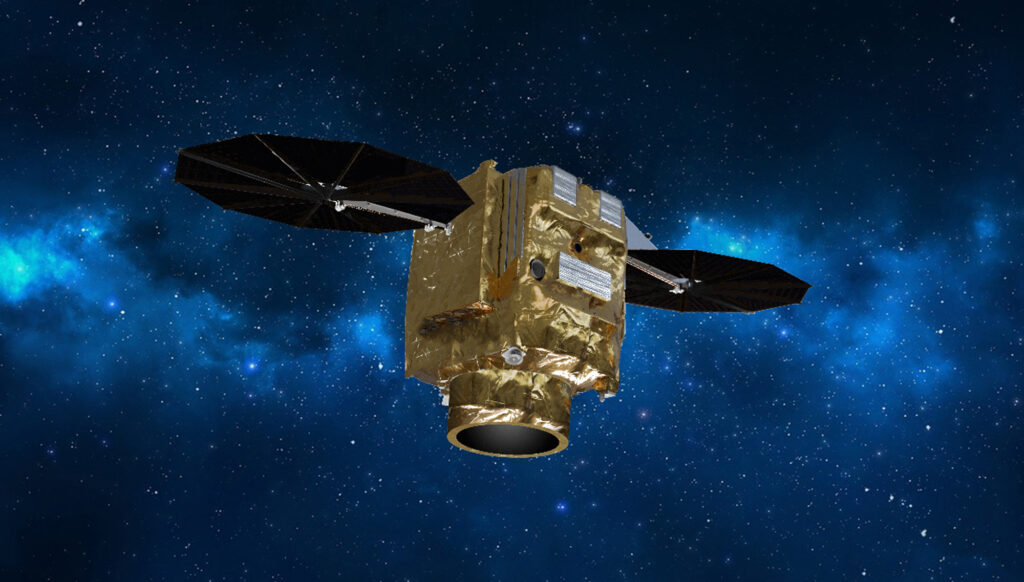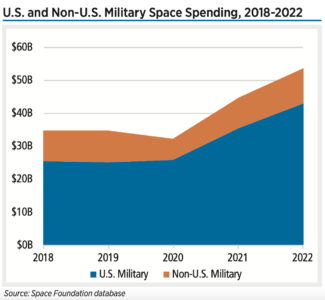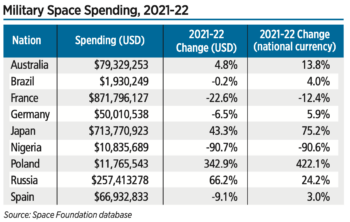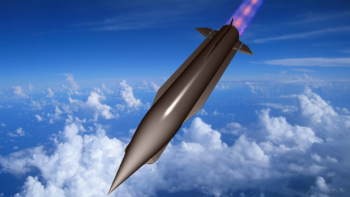
With its pumped up military space budget, Poland has inked a deal with European satellite maker Airbus to buy imagery from its Pléiades Neo constellation.
WASHINGTON — The Space Foundation’s latest report on the space economy, covering 51 countries and government organizations, shows that military space spending jumped in 2022 to an estimated $54 billion from some $45 billion in 2021 — with the US Defense Department responsible for a majority of the known expenditure.
The Space Report 2023 Q2 study estimates that the Pentagon’s classified and unclassified spending in 2022 hit almost $43 billion. That sum is expected to jump to $54 billion in 2023, according to a copy of the report provided to Breaking Defense. Total US government space spending went from $61 billion in 2021 to $69 billion inn 2022, and is expected to grow to $82 billion.
There is a significant caveat to the global military space numbers, as the report notes that estimates are “murky” at best for China, the second-largest space spender overall, due to Beijing’s blending of civil and military space operations. Instead, it notes that China spent an estimated $16 billion across its government in space operations, and that about a third of space launches were thought to be military-related.
Meanwhile, it estimates Russia spent some $257 million on military space projects.

But it was the actions of those two nations that in part prompted increased spending elsewhere, the report said.
“Military space spending also increased around the globe amid rising tensions stemming from the Russian invasion of Ukraine and growing rivalries with China in the western Pacific,” the Space Foundation said in a press release Tuesday.
Of eight other nations reviewed in the report, Japan had one of the most striking increases in annual space spending between 2021 and 2022, going from ¥55 billion ($390 million) to ¥97 billion ($688 million), a whopping 75 percent jump. Tokyo’s Ministry of Defense is expected to pump that up even higher in 2023 to ¥128 billion ($908 million). Most of the funding increase is targeted at intelligence, surveillance and reconnaissance and satellites communications, the report explained. (Indeed, the MoD is testing SpaceX’s Starlink satellites that provide high-volume communications and internet services to augment its capabilities, according to a June 24 report by Reuters.)
 Poland, which borders Ukraine, also significantly pumped up its minuscule defense space budget of some $2 million to almost $12 million, the report found. Among future Polish spending plans, the Space Foundation report noted, is a January deal with European aerospace giant Airbus to buy two of its Airbus S950 VHR optical imaging satellites, plus imagery services from the company’s newest generation Pléiades Neo constellation.
Poland, which borders Ukraine, also significantly pumped up its minuscule defense space budget of some $2 million to almost $12 million, the report found. Among future Polish spending plans, the Space Foundation report noted, is a January deal with European aerospace giant Airbus to buy two of its Airbus S950 VHR optical imaging satellites, plus imagery services from the company’s newest generation Pléiades Neo constellation.
Meanwhile, the commercial space sector also continued its year-long boom. Overall, the foundation found that the global space economy grew 8 percent from 2021, reaching $546 billion in 2022.
“The Space Report forecasts continued growth in the space economy, and based on our conservative modeling, we anticipate nearing the $800 billion mark within five years,” said Thomas Dorame, senior vice president at Space Foundation. “This forecast is bolstered by the increase in 2023 space launch activity, which is well on pace to surpass the annual record set in 2022.”






















